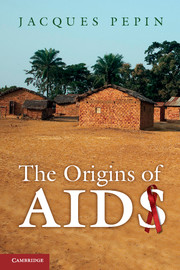 Tinderbox: How the West Sparked the AIDS Epidemic
Tinderbox: How the West Sparked the AIDS Epidemic
and How the World Can Finally Overcome It
by Craig Timberg and Daniel Halperin
Penguin Press. 432 pages, $29.95
 The Origin of AIDS
The Origin of AIDS
by Jacques Pepin
Cambridge University Press
310 pages, $85.
THE FIRST GAY PERSON I ever met was also the first lover who died of AIDS. Tom was an ebullient bon vivant who loved to cook, built his own clavichord, and snuck me into the Episcopal church where he was the organist to play Bach works till dawn. Unbeknownst to us when we met in 1980 (my freshman year of college), HIV was silently insinuating itself into the bloodstream of men and women around the globe. It sprung into the public’s attention in 1981 after physicians published a report on an unusual outbreak of Pneumocystic pneumonia (PCP) affecting five previously healthy young gay men in Los Angeles with weakened immune systems. An editor of the Morbidity and Mortality Weekly Report noted, “The fact that these patients were all homosexuals suggests an association between some aspect of a homosexual lifestyle or disease acquired through sexual contact and [PCP] in this population.”*
Soon the mysterious disease was dubbed Gay-Related Immune Deficiency, or GRID. Tom and I traveled around Europe in 1984; by then the epidemiology of AIDS and mode of transmission of HIV were better known, but it had become a terminal illness that was devastating the gay community. It was the focal point of my experience as a young gay man and gay cultural politics of the mid-1980’s. I remember attending an HIV conference at the Harvard School of Public Health, and after it was over blocking traffic on the street in front of the conference hall as part of a Boston ACT UP “die-in” to protest Reagan administration policies on AIDS drug testing and availability. No gay man or lesbian alive in the 1980’s was unscathed by the tsunami of AIDS deaths.





